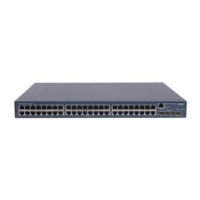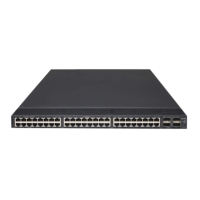1-6
z Do not set the voice VLAN as the default VLAN of a port in automatic voice VLAN assignment
mode. Otherwise, the system prompts error information. For information about voice VLAN, refer to
Voice VLAN Configuration.
z The local and remote ports must use the same default VLAN ID for the traffic of the default VLAN to
be transmitted properly.
A port configured with the default VLAN handles a frame as follows:
Actions (in the inbound direction)
Port type
Untagged frame Tagged frame
Actions (in the outbound
direction)
Access
Tag the frame with
the default VLAN
tag.
z Receive the frame if its
VLAN ID is the same
as the default VLAN ID.
z Drop the frame if its
VLAN ID is different
from the default VLAN
ID.
Remove the default VLAN tag and
send the frame.
Trunk
z Remove the tag and send the
frame if the frame carries the
default VLAN tag and the port
belongs to the default VLAN.
z Send the frame without
removing the tag if its VLAN is
carried on the port but is
different from the default one.
Hybrid
Check whether the
default VLAN is
permitted on the
port:
z If yes, tag the
frame with the
default VLAN
tag.
z If not, drop the
frame.
z Receive the frame if its
VLAN is carried on the
port.
z Drop the frame if its
VLAN is not carried on
the port.
Send the frame if its VLAN is
carried on the port. The frame is
sent with the VLAN tag removed
or intact depending on your
configuration with the port hybrid
vlan command. This is true of the
default VLAN.
Assigning an Access Port to a VLAN
You can assign an access port to a VLAN in VLAN view, interface view, or port group view.
1) In VLAN view
Follow these steps to assign one or multiple access ports to a VLAN in VLAN view:
To do… Use the command… Remarks
Enter system view
system-view
—
Enter VLAN view
vlan vlan-id
Required
If the specified VLAN does not exist, this
command creates the VLAN first.
Assign one or a group
of access ports to the
current VLAN
port interface-list
Required
By default, all ports belong to VLAN 1.

